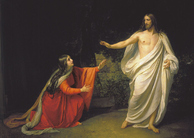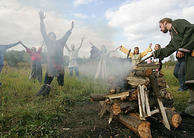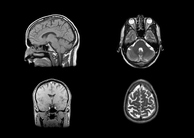The Tongue of the Learned: How the Elaboration Likelihood Model and Group Communication Can Improve Biblical Literacy
By
2012, Vol. 4 No. 12 | pg. 3/3 | « V. DiscussionTrade-offs Every policy presents trade-offs which the client has to evaluate to determine if the alternative is worth the opportunity cost. As it pertains to this study, the field should be advised that the decrease in free-riders was a mix between free-riders becoming contributing members, contributing members inviting like minded friends, and free-riders resigning their membership – this being the majority of the occurrence. If the church leadership staff’s goal is high attendance, employing this method could reduce attendance as free-riders may resign their membership. This method will cause each clergy member to face the quality v. quantity of content trade-off. What is meant by quality is the degree in which parishioners comprehend the message taught; quantity refers to how much content can be covered during the particular time frame. As seen in SGC, the pastor had extensive notes regarding the specific topic to be discussed; however, more often than not, he could not cover all of the content he desired during service. Engaging and gauging the audience takes time; one must choose between how much quality will be chosen over the quantity of content. When one juxtaposes the Socratic and Episcopal method, the Episcopal method allows for a larger amount of information to be disseminated at the digression of the speaker. However, the Socratic method governed by ELM and group communication, moderates the amount of content by the level to which the audience understands the current concept.Placing the Onus on Clergy A policy debate exits within biblical literacy scholarship which argues the question of whether or not the public sector should be involved in improving biblical literacy. While it is common knowledge that churches were America's first primary schools (Brackens 2011), today, religious content taught within schools by public officials can be a violation of the First Amendment's Establishment Clause. Prothero (2007) suggests that all major religions should be taught as to foster understanding and appreciation of the various beliefs; while Stetson & Scurry (2005) suggest a Bible class be taught in schools. Prothero's (2007) recommendation is more "constitutionally safe" than what Stetson & Scurry (2005) propose. On its face, teaching a voluntary Bible class within public schools could be harmless; however, the harm is determined when one answers the question as to the extent to which the curriculum will be modified and governed by public officials (e.g., teachers, principles, etc.)? As seen in the Supreme Court case Lee v. Weisman (1992), a public official's involvement to shape religious messages that favor a particular religion is a violation of the First Amendment. If it is clear that a Bible class taught in a public school favors a particular religion (i.e., Christianity), it then becomes clear that it sincerely teeters toward unconstitutionality. A compromise can be reached: world religions may be taught in secondary schools to increase religious literacy as it has impacts on national security, but biblical literacy should remain the responsibility of religious institutions. Furthermore, initiatives such as the Obama Administration's "Interfaith and Community Service Campus Challenge" (ICSCC) are commended. Critically speaking, it is understood that the majority of Americans will not pursue post-secondary education; ergo, it stands to reason that the cohort of interest should of necessity be students seeking secondary education. However, the venue in which these students are educated is heavily guarded by the establishment clause, thus one would do well if s/he seeks to educate this demographic in ways similar to Prothero (2007) and ICSCC. Nevertheless, there remains a feasible policy alterative: biblical literacy can improve via clergies' employment of ELM and group communication. In short, Americans can avoid the potential of establishment clause infringements if we leave the onus of biblical literacy to clergy and suggest that they implement the methods discussed within this research. Proposed Policy v. Status Quo The research's policy and the trade-offs it engenders speak to a larger issue regarding current structures: do status quo church structures foster adequate retention of biblical and religious knowledge? Pew Forum's (2010) findings would suggest not, as the average Christian American can only correctly answer 47 percent of questions regarding religious knowledge. Furthermore, as one analyzes biblical illiteracy among racial lines, it appears that the more church services Black Christian/Protestants attend, the worse they perform in comparison to their White counterparts (Brackens, 2012). These findings are indicators of how well status quo religious structures foster biblical literacy; they also suggest that structures and approaches must be modified if we hope to see these negative trends reverse. However, with a common resistance to change, people's avoidance of uncomfortable situations, and religion largely being a function of and sustained by tradition, large and mainline denominations may be highly reluctant to divorce status quo and court a slightly younger and more high maintenance model: the Socratic Method. VI. Conclusion, Limitations & Call for Further ResearchThis study supports the assertion that clergy's incorporation of ELM and Group Communication significantly improves comprehension of biblical concepts among the parishioners surveyed. Additionally, the aforementioned leads to significant reductions in the amount of free-riders within the religious organization. To that end, it improves the organization's ability to correlate total contributions with total attendance. However, we acknowledge that this research does not come without its limitations. First and foremost, respondent results, although compelling, do not meet EPSM techniques that increase the probability of drawing a representative sample of American laity. The results are specific to the situation faced in SGC; further research should be completed with a representative sample to better speak to the extent of this policy's impact. Secondly, the measurement of biblical knowledge is actually an indicator of how the person feels s/he can understand and apply said knowledge. Although laity satisfaction in his/her ability to comprehend and apply scripture is a good economic measure (Krugman & Wells, 2009:14; McCluskey, 2010:16), it does not empirically speak to if the knowledge is actually retained. To better address knowledge retention, one should employ the methods espoused within the research and test respondent's ability to identify and interpret specific religious concepts pre and post-implementation. Lastly, the simplicity of the one-tailed T-Test does not allow one to measure the impacts of the communication methods applied versus the benefits to communication engendered by education. Parishioners' improvement could be a function of the pastor's ability to better explain concepts and construct cogent arguments. To improve upon this research, one should construct three test groups and one control group and evaluate them similar to the structure detailed below:
This will allow one to determine the extent to which both elements impact biblical knowledge retention. In the meantime, the field should use this study as a point of departure to conduct further research regarding employing communication theory to help improve biblical knowledge retention and literacy. ReferencesArgote, L., & Igram, P. (2000). Knowledge Transfer: A Basis of Competitive Advantage in Firms. Organizational Behavior and Human Decision Processes, 82(1), 150-69. Barnlund, D. C. (1970). A Transactional Model of Communication. New York, New York : Harper & Row. Bell, R. (2006). Velvet Elvis: Repainting the Christian Faith. Grand Rapids, MI: Zondervan. Blake, J. (2011, September 3). Four ways 9/11 changed America's attitude toward religion. CNN, pp. 1-5. Retrieved August 23, 2012, from http://religion.blogs.cnn.com/2011/09/03/four-ways-911-changed-americas-attitude-toward-religion/ Brackens, D. L. (2008). Crisis of Change. Bloomington, IN: Xlibris Corp. Brackens, J. D. (2010). The Matthaean Exception Clause: A 21st Century Interpretation. Student Pulse, 2(10), 1-20. Retrieved August 15, 2012, from Brackens, J. D. (2011). Is Paul a Liar? The Pauline Corinthian Conflict and the Need for Reform in the American Church. Student Pulse, 3(5), 1-15. Brackens, J. D. (2012). Feed My Sheep: Analysis of the Black-White Biblical Academic Achievement Gap. Southern States Communication Association 82nd Annual Conference (pp. 1-38). San Antonio: SSCA. Retrieved April 15, 2012 Craigie, P. C. (1976). The Book of Deuteronomy. Grand Rapids, MI: Eerdmans. Derrett, D. (1983). Binding and Loosing (Matt 16:19; 18:18; John 29:23). Journal of Biblical Literature, 102(1), 112-17. Edmondson, A. C. (1999). The Local and Variegated Nature of Learning in Organizations: A Group-Level Persepective. Organizational Science, 13(2), 128-46. Froemling, K. K., Grice, G. L., & Skinner, J. F. (2011). Communication: The Handbook. Boston, Massachusetts: Allyn & Bacon. Griffin, E. A. (2009). A First Look at Communication Theory (7th ed.). Boston, Massachusetts: McGraw-Hill Higher Education. Hargadon, A. B. (1999). Group Cognition and Creativity in Organizations. Research on Managing Groups and Teams, 2(1), 137-55. Harrison, G. W. (1987). Covenant Unfaithfulness In Malachi 2:1-16. Criswell Theological Review, 2(1), 63-72. Hinton, M. D. (2009). Back to the Future: Re-Appropriating Religious Education -- A Case Study Using the Black Church. Religious Education , 104(1), 18-37. Krugman, P. R., & Wells, R. (2009). Microeconomics (2nd ed.). New York, New York: Worth Publishers. LEE et al v. WEISMAN, personally and as NEXT FRIEND OF WEISMAN 505 U.S. 577 , No. 90-1014. (The Supreme Court June 24, 1992). McCluskey, N. (2010). Behind the Curtain: Assessing the Case for National Curriculum Standards. Policy Analysis, 1-36. Retrieved October 19, 2011, from http://www.cato.org/publications/policy-analysis/behind-curtain-assessing-case-national-curriculum-standards O'Donnell, E. (1984). Making Use of Communication Theory. An Irish Quarterly Review, 73(292), 324-30. Owens, I. (1985). The Importance of a Library Within the Black Local Church. Journal of Religious Thought, 42(2), 62-68. Petty, R. E., & Cacioppo, J. T. (1986). Communication and persuasion: Central and peripheral routes to attitude change. New York, New York: Springer-Verlag. Prothero, S. (2007). Religious Literacy: What Every American Needs to Know. New York, New York : HarperCollines. Row, G. W., & Guerrero, L. (2011). Cases in Leadership. Los Angeles, California: Sage Publications. Rybacki, K. C., & Rybacki, D. J. (2008). Advocacy and Opposition: An Introduction to Argumentation (6th ed.). Boston, Massachusetts: Allyn & Bacon/Person Education. Senge, P. M. (1990). The Fifth Discipline: The Art and Practice of the Learning Organization. New York, New York: Doubleday/Currency. Stetson, C., & Scurry, R. (2005). Bible Literacy Report: What do American Teens Need to Know and What Do They Know? Bible Literacy Project, 1(1), 1-58. Retrieved from http://www.bibleliteracy.org/Secure/Documents/BibleLiteracyReport2005.pdf The Pew Forum on Religion & Public Life. (2010, September 28). 2010 RELIGIOUS KNOWLEDGE QUESTIONNAIRE. Washington, D.C., USA. Retrieved from http://www.pewforum.org/Other-Beliefs-and-Practices/U-S-Religious-Knowledge-Survey.aspx Wong, S.-S. (2004). Distal and Local Group Learning: Performance Trade-Offs and Tensions. Organization Science, 15(5), 645-56. 2.) http://www.whitehouse.gov/administration/eop/ofbnp/interfaithservice 3.) http://www.pewforum.org/U-S-Religious-Knowledge-Survey-Who-Knows-What-About-Religion.aspx 4.) Brackens (2012) spoke to the possibility but admitted that the data reviewed could not measure its impacts. 5.) Please note that we did not sum the amount of contributions; rather, we reviewed the total number of times a member contributed. Suggested Reading from Inquiries Journal
Inquiries Journal provides undergraduate and graduate students around the world a platform for the wide dissemination of academic work over a range of core disciplines. Representing the work of students from hundreds of institutions around the globe, Inquiries Journal's large database of academic articles is completely free. Learn more | Blog | Submit Latest in Theology | ||||||||||||

















